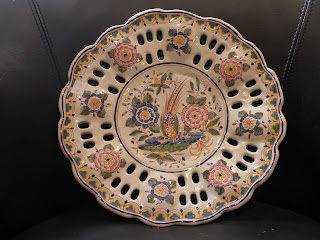Quimper (pronounced 'kem-pair') pottery comes from the town of Quimper, in the department of Finistere, a region of Brittany on the North Atlantic coast of France, at the confluence of the Odet, and Steir rivers, ('Quimper' comes from the Breton kemper - 'confluent'). The Bretons arrived in the area from the Celtic fringes of Britain, (from Cornwall, Wales, Ireland, Cumberland, Man and Scotland), in the fifth and sixth centuries; the Breton language is very closely linked to Gaelic, and the Bretons regard themselves as a separate people rather than French (they voted to become an independent nation after WWII, although the French government rejected the proposal).
Pottery has been made in the area for centuries but 'modern' Quimper pottery dates from the early 1700s onwards, and Quimper pottery is now the term for the opaque, tin-glazed earthenware that is made there. The French term for this type of ware is 'faience', taking its name from Faenza, in Northern Italy, where maiolica pottery was made (maiolica, not majolica - which was a trade name for Victorian Minton pottery). In the Netherlands it is Delft, in England it is Delftware. Faience is very difficult to make, and there is a demarcation (the end of WWII) between 'vintage' Quimper, and the modern product. There were three factories in Quimper; the Grand Maison, Porquier and Henriot, which marked their pottery variously HB, AB, PR, HR or HenRiot, but for a number of reasons the mark might well not come from an expected factory (the designs, and rights to them, were affected by buy-outs, take-overs, and relaunches). It's a complicated world.
One of the most popular decoration is the 'petit Breton' design, depicting naive figures in traditional Breton costume, with men in their round-crowned, broad-brimmed hats, and women in full skirts and aprons. I find them charming. Here is a goblet in the style which I picked up for a pound in a charity shop.
The style is not restricted to pottery. Here is a biscuit tin I bought in Brittany about ten years ago.
And faience is not limited to Brittany, Here is a pierced wall-plate from Portugal, again picked up in a charity shop, for £1.50.
 |
| Close up of the pheasant in the centre of the plate. |
I'm suspecting this was made for export - the back says 'Hand Painted Portugal', whereas one might more reasonably expect Pintado por mão or even Feito em Portugal.
 |
| Detail of the back inscription. |
* Degemer met is Breton for 'Welcome'.






No comments:
Post a Comment